Compress files with Movavi Video Converter!
Easy compression and editing
Lightning-fast conversion
Batch processing of files – any number, any size
No quality loss, even with 4K videos
Everyone has to send a large file now and then, and as we know, it can’t be done without compression. This article takes three of the most popular programs and lays out everything you need to know when making a choice between 7-Zip vs. WinRAR vs. WinZip.
Here’s what Movavi’s team does to provide you with verified information:
When selecting products to include in our reviews, we research both demand and popularity.
All the products covered in this article have been tested by our team.
When testing, we compare key characteristics, including supported input and output formats, quality loss when converting, and other significant features.
We study user reviews from popular review platforms and make use of this information when writing our product reviews.
We collect feedback from our users and analyze their opinions of Movavi software as well as products from other companies.

Special pick: Movavi Video Converter
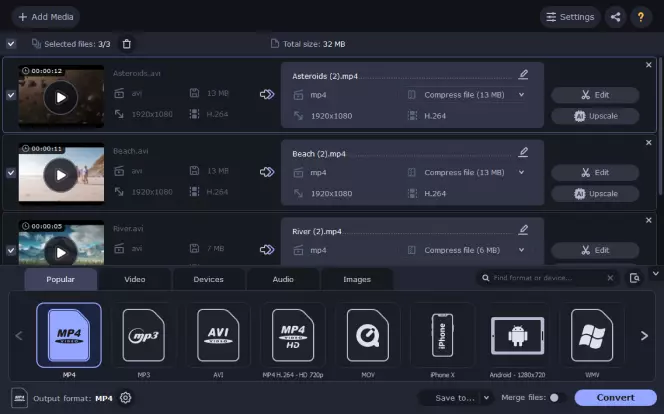
This review covers WinRAR vs. 7-Zip vs. WinZip, but our special pick alternative for compression is Movavi Video Converter. This program has everything you need to compress, edit, and convert video files – in over 180 formats – without losing quality. It’s the perfect compression program for advanced users and beginners and comes with a free trial version.
One Hour Professor calls it one of the fastest and most cost-efficient converters on the market today. Follow this link to read the review:
With that, let’s dig into the important parameters when choosing between WinZip vs. 7-Zip vs. WinRAR. Below, there is a breakdown of each software that tells you which platforms and file formats they have support for, licensing information, compression rate, file size limitation, security protocols, and their key features.
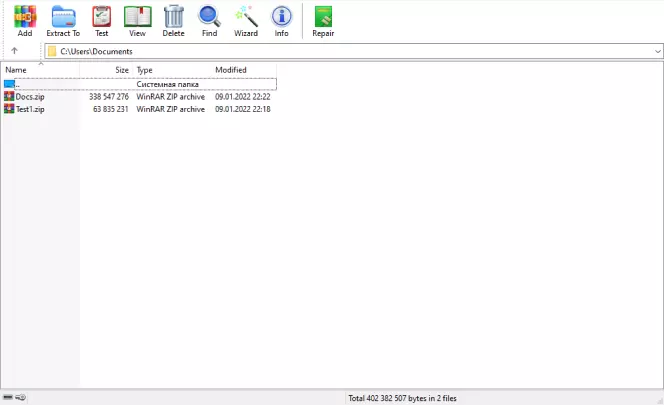
TechRadar rating: 4 out of 5
Supported platforms
WinRAR only works on the Windows platform – XP and later, including 11. But they offer software called RAR for Mac and Linux. The key difference between the two is that WinRAR has a graphic interface, whereas RAR can only run directly from the command line.
Supported file formats
WinRAR can decompress a wide range of common formats, including RAR, ARJ, LZH, GZip, UUE, CAB, TAR, ISO, Z, 7-Zip, and BZIP2. But it only compresses in RAR or ZIP.
License
Each WinRAR license costs $29.99 plus $4.35 for the maintenance package, and both are lifetime purchases. The software comes with a 40-day trial and is available in over 50 languages. They also have a physical version on CD available for $9.99 per order.
Compression rate and file size, compression method
With WinRAR, you can compress and create either a RAR or ZIP file, and the program automatically helps you to select the best compression method for your file.
Based on the type of file and compression you need, tests have shown WinRAR to compress up to 40% of the original file in RAR format. RAR always has a faster compression rate than ZIP when using WinRAR, but its overall compression rate is slower than WinZip or 7-Zip. However, the program is always speedy when you need to unzip a file and is easily the best RAR extractor.
Security
In the security battle of WinRAR vs. 7-Zip vs. WinZip, WinRAR matches the competition with 256-bit password encryption available. But remember that encryption isn’t worth anything if you don’t have a strong password.
Features
Besides the wide range of supported formats and security features, WinRAR also has an intuitive interface that allows you to weave between its various functions with ease.
The wizard within the program is great for speeding up the compression process and comes with a virus scanner. This feature can be a lifesaver for beginner users in file compression, as the program has a wide range of configuration and security settings. However, you can also store your configurations as a profile for use later to save time.
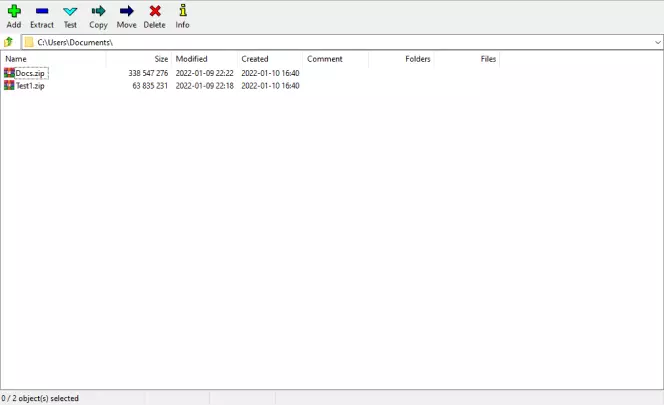
TechRadar rating: 4 out of 5
Supported platforms
7-Zip works on Windows, Linux, and macOS platforms.
Supported file formats
7-Zip packs files in 7z, GZIP, XZ, BZIP2, WIM, ZIP and TAR formats. It can unpack CramFS, NTFS, AR, VHD, CAB, SquashFSCPIO, DMG, NSIS, EXT, ARJ, GPT, ISO, LZMA, MBR, IHEX, MSI, HFS, CHM, QCOW2, RAR, LZH, RPM, UDF, FAT, UEFI, VMDK, Z, WIM, VDI, and XAR.
License
If you need a free zip file opener or for any other compressed file type, 7-Zip is the answer. The program is open source and always free for everyone.
Compression rate and file size, compression method
7-Zip archives files at a very high compression rate, typically in its proprietary 7z format using either its own LZMA or LZMA2 methods. Both methods compress at around 1 MB/s on a 2 GHz CPU and can decompress at around 10-20 MB/s on 2 GHz CPU. When comparing 7z vs. WinRAR and WinZip compression speeds, 7-Zip is typically a little slower.
The program will give you a file size around 40% of the original file.
Security
Like WinZip, 7-Zip offers AES-256 password-protected encryption in the ZIP format, but it also offers this encryption in 7z.
Features
Besides the security and various formatting options available for compression and decompression, 7-Zip has a variety of customization options within its interface.
There are two methods of using the tool. You can either compress files within the file manager or you can use a context menu – using a right-click – to select from a range of compression options. Overall, the program can be a little confusing for beginners, but everything has a logical layout that you can learn with a few uses. An archive repair tool is also available.
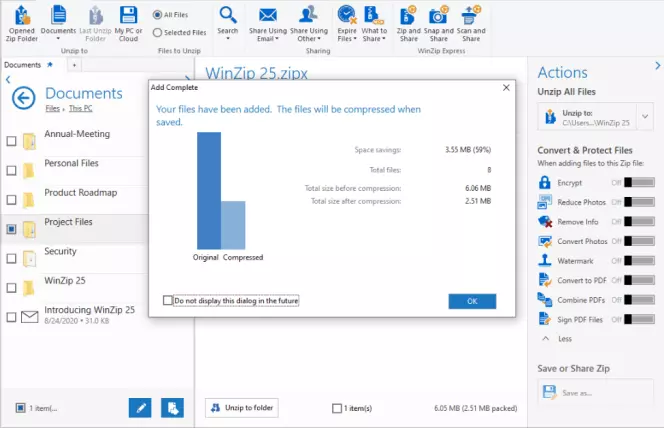
TechRadar rating: 4 out of 5
Supported platforms
WinZip has both a Windows and macOS version available for download.
Supported file formats
WinZip can compress files in ZIP and, unlike WinRAR or 7-Zip, it can also compress in IHA/IHZ or UUencoded if you run WinZip 12 and higher. WinZip can decompress ZIP, TAR, GZIP, Compress, CAB, RAR, BZ2, IHA/IZH, 7Z, IMG, ISO, XZ, VHD, and VMDK.
License
A WinZip license runs $29.95 per year with the ability to cancel at any time.
Compression rate and file size, compression method
WinZip uses an archival compression method that typically creates a ZIP or ZIPx file based on what you select. Tests have shown ZIP files to hover around 30% of the original file and ZIPx around 40%. WinZip will always beat 7-Zip or WinRAR for compression speed on ZIP files.
Security
Like 7-Zip, WinZip offers 256 bit AES encryption with password protection.
Features
The features for WinZip may make the software seem a little better than WinRAR or 7-Zip for some – even with the higher price tag. You get the security and compression features listed above, but WinZip also offers the ability to run multiple compressions at once. This is huge for any user who does a lot of compressions. WinZip comes with a PDF converter that can go both ways in converting PDF and Word files. And it also has a key feature called ZipSend that enables you to attach large files to emails. It works by zipping and transferring the files through the same system. Plus, you can send ZIP files that self-extract in case you work with individuals who aren’t too keen on how file compression works.
We read several compression test reviews among these three programs and opted to provide figures related only to their individual settings for optimal compression. Here, that’s ZIP and ZIPx for WinZip, RAR4 and RAR 5 for WinRAR, and 7z for 7-Zip.
The tests we referenced used two separate file sizes with a large group of MP4 video files and then a complex ISO file. Both file types are easy to compress for these programs and thus reflect their true speed.
Overall, there’s not a sizable difference between the different file types as they all averaged between 30 and 40 percent compression. So, to find your best option, it may be time to look at the price tag.
By seeing all the functions, compatibility, and features for each program, we hope you’ve gained some insight into these programs. It isn’t up to us to answer the question ‘Which is better: 7-Zip or WinRAR or WinZip?’ because every user has different needs. However, we can tell you some important questions to consider before making your choice:
Is the program user-friendly?
Test and review the interface and functionality of each of these three programs to ensure that you can use it well and it works with your experience level. It’s great if a program has a lot of bells and whistles, but they won’t do you any good if you can’t navigate the software to use them.
Does it have the features I need?
We listed out many of the features for each of these programs above. But it’s good practice to visit their individual websites to make sure and see that everything you want is incorporated into the program at a price point that suits your budget.
Does it support the formats I need?
These three programs support a laundry list of formats, so be sure to review and see if it supports the ones you use regularly.
What do the user reviews say?
Don’t just take our word on these programs. Check out user reviews on the web to see what people think of the programs and to see if they point out any common issues or bugs.
What type of support does the software offer?
For any program, you want to have access to support when you need it. Review if they offer common support channels like email, live chat, online, or even phone support.
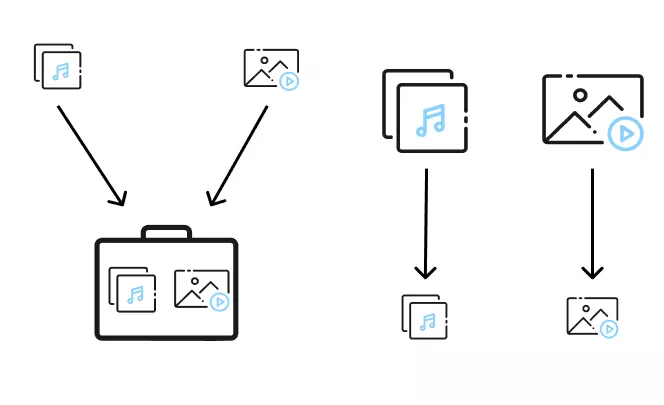
To start, let’s look at archiving. Archiving happens when a program creates a file that has additional – at least two – files and metadata within the file. Archiving doesn’t lower the file size, rather, it bundles everything together in a more efficient manner. Therefore, many compression programs use archiving besides their compression functions.
Compression actually reduces the size of a file by taking out redundant information from each file and then creating a reference for later use when you decompress the file. This allows you to send the files over the internet much easier and for users to lower the amount of needed storage.
Whether you want to archive, compress or do both depends on your needs. People generally only archive things if they’re making a backup copy of something. Whereas archiving and compression, or only compression, are useful when transmitting data across the web.
Movavi Video Converter is an all-in-one video conversion program that can help you compress and send large video files in no time. It works in a wide range of formats, including MP4, MOV, MKV, WMV, and much more.
To compress any file with Movavi Video Converter, follow these steps:
Simply click the Add Media button and then Add Video at the top left of your screen. From there, choose your video and then click Open.
Then open the Video tab, select a format group and choose a preset.
Once you choose a format, you’ll return to the source file list and select a file size. To do this, move the File size slider to the bitrate and file size you desire. You can even view a sample beforehand if you click the Convert sample button.
Last, simply choose an output folder by clicking the Save to button. If you don’t, the file will route to the Movavi Library folder by default. Then, click the Convert button to start the process. Your output folder will auto-open afterwards.
Movavi Video Converter
The ideal way to get your media in the format you need!
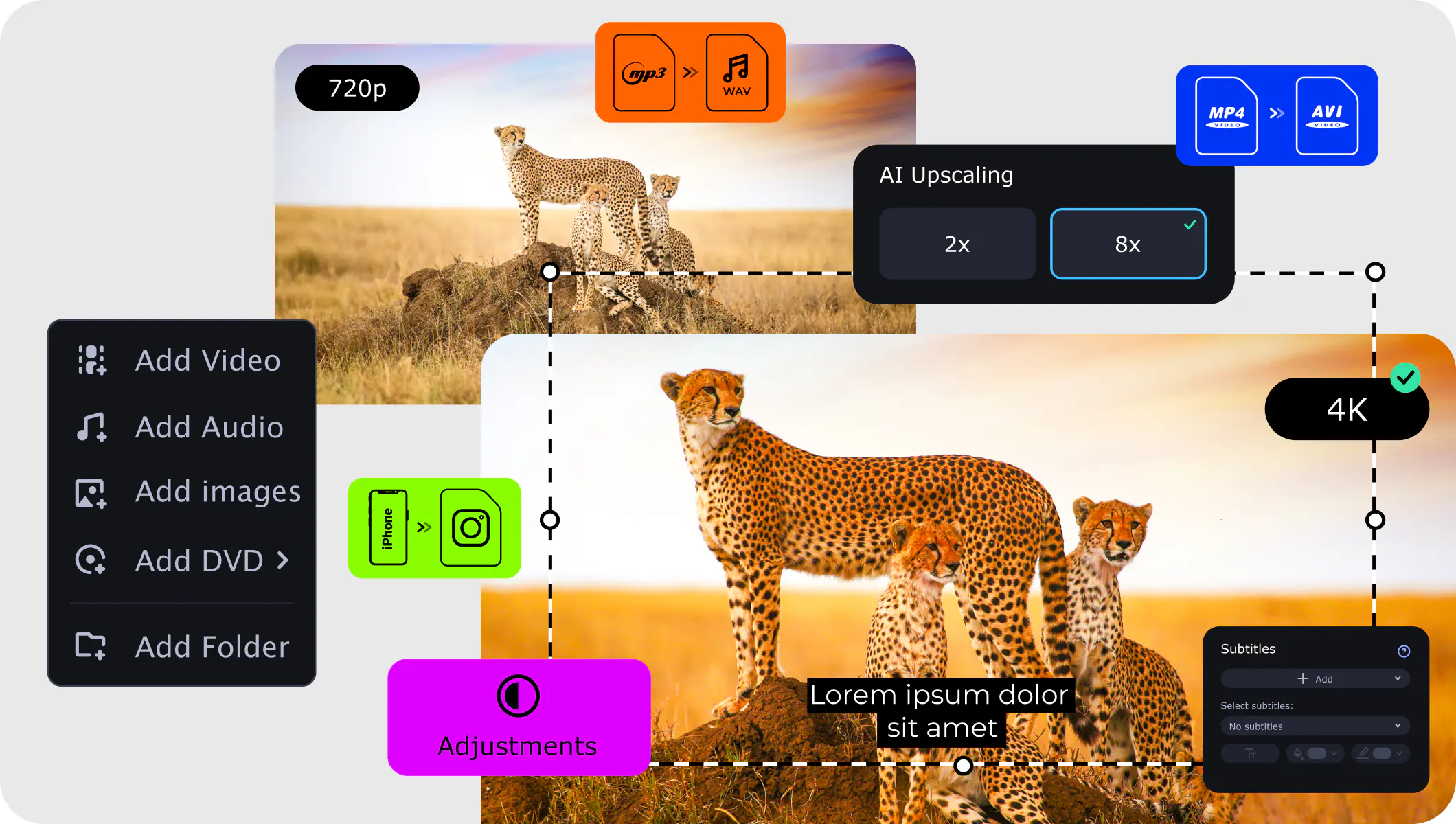
Frequently asked questions
See other useful how-to guides

Have questions?
If you can’t find the answer to your question, please feel free to contact our Support Team.
Join for how-to guides, speсial offers, and app tips!
1.5М+ users already subscribed to our newsletter